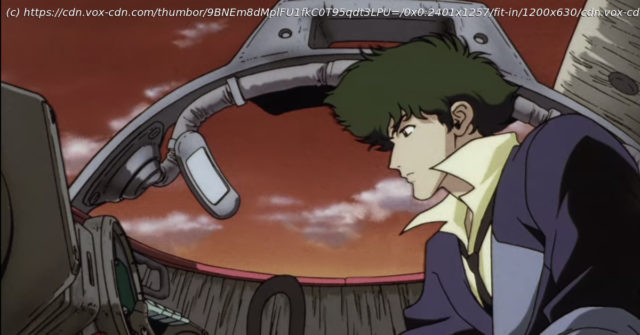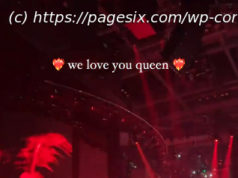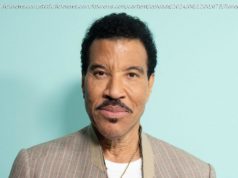Everything you need to know about the legendary anime — and why there’s so much riding on Netflix’s remake.
Halfway through the fifth episode of Cowboy Bebop, the seminal late ’90s anime series about a roguish bounty hunter fighting crime and traveling through space, the show explains itself. A title card briefly appears on screen, and we see what looks like a pitch for the very show we’re in the middle of watching. “This is not a kind of Space Opera,” the card reads, referring to the by-then-well-trodden genre of epic spaceship flyovers and majestic, exotic fantasy worlds in the far reaches of the galaxy. “It is a sort of Space Jazz which is filled with street sense and life.” The card acknowledges past media portrayals of space exploration such as Star Wars and Apollo 13 (along with esoterica and cheeky metaphors) but stresses this story is different: “We show you a completely new visual world,” it promises. In 1998, with Japanese animation enjoying a golden age and sci-fi moving toward a resurgence, Cowboy Bebop wasn’t completely new, either aesthetically or narratively, but it was close enough to capture the hearts of legions of fans and become widely acknowledged as one of the most important anime series ever created. If you’re an anime fan, even if you’ve never watched the show, you definitely know its main character, well-dressed bounty hunter Spike Spiegel; its famous opening-theme music; and its tagline — “See you, space cowboy.” And, crucially, whether you’re an anime fan or not, you likely know its influence. On November 19, Netflix debuts a new, live-action reboot of Cowboy Bebop starring John Cho that looks a lot like some cultural touchstones: Firefly, Kill Bill, Guardians of the Galaxy. Some of these well-loved properties may well have been influenced by the original anime series, both visually and in plotting. But while many stories have followed in Bebop ’s wake, few have done it better. Cowboy Bebop was one of the first anime series to not only prove there was an adult audience for mature anime stories, but also to break through to mainstream adult audiences in the US. That loyal fanbase means there’s a lot riding on Netflix’s new adaptation: pressure to maintain the spirit of the original show while paving the way for more live-action anime adaptations to come. How well does it compare to the original, and why does it all matter? Read on to find out. Okay,3–2–1, let’s jam! Cowboy Bebop was originally supposed to be something much different Cowboy Bebop was the brainchild of director Shinichirō Watanabe, who created the original series in the ’90s on behalf of the Japanese toy and entertainment company Bandai. At the time, despite serious genre-elevating films like Akira (1988) and the works of Studio Ghibli, anime was still very much a medium for children’s storytelling, and Bandai wanted Watanabe to create a show that would popularize spaceship toys. The show Watanabe came up with was hardly the fun children’s spaceship series Bandai expected. Sure, the animation was engaging and often beautiful, and the characters — a gang of bounty hunters with spurious pasts, led by Spike and his partner Jet Black, pitted against a criminal mastermind called Vicious — had plenty of universal appeal. But the story was violent, veering from comedic to existential, and each character had depth that was rare for anime of the period. Though the show was episodic, the main storyline was dark, with themes of sexuality and death and a resolution that left little room for a second season. The toy division pulled out, and the project languished in production limbo for a few years until Bandai’s animation vertical, Bandai Entertainment, took it over. It gave free reign to Watanabe and the show’s animation studio, Sunrise. The result was a show unlike most anime of the time. Mainstream anime series of the era tended toward sprightly adaptations of shounen manga starring preteen boys — sports and adventure fantasies such as Gundam Wing and Dragon Ball Z, all aimed squarely at children and teen viewers. The most popular series were long-running and episodic. Bebop, by contrast, was a self-contained single season focused on adult characters, with sophisticated themes and a strong emphasis on aesthetic alongside plot. Music was front and center. Episodes were called “sessions” (after recording sessions), with each one’s title and musical cues referencing a different jazz or rock icon — everyone from Herbie Hancock to Aerosmith. Musician Yoko Kanno created the show’s soundscape by pairing jazz and rock music with familiar visual action tropes; the improvisational style of ’50s-era bebop serves as a sonic analogue for our heroes’ rough-and-tumble lifestyle. Bebop even doubles as the name of Spike’s spaceship. Though Bebop ’s highly stylized, jazzy fight scenes might seem routine to viewers, thanks to the countless works that have imitated them since, they were new and innovative at the time.






